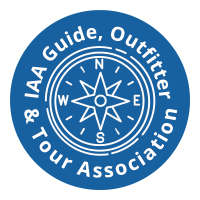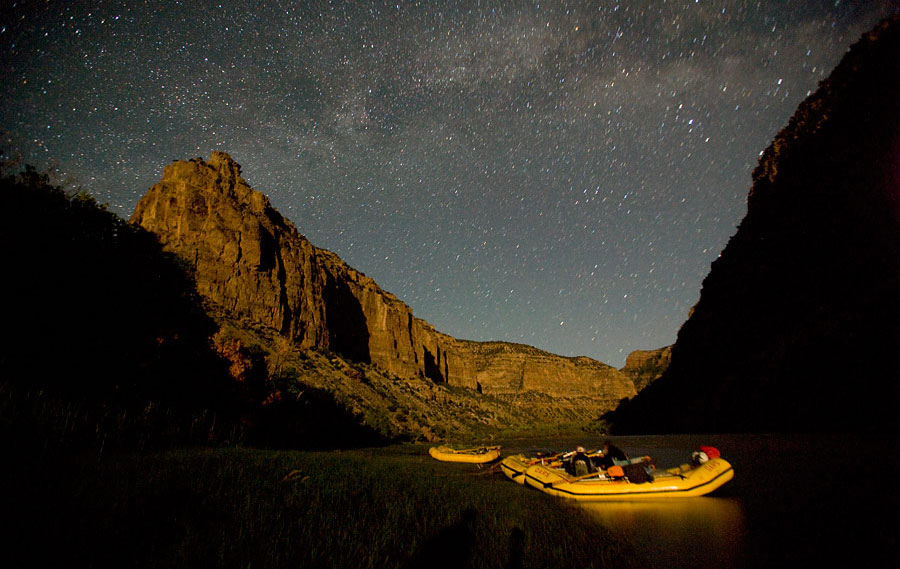Gone are the days when most people could look up and see the Milky Way. Our night skies are disappearing. Currently, 80 percent of the world is affected by light pollution, including an estimated 99% of people living in the continental U.S. and Europe. This has deprived many of us the chance to experience one of life’s simple joys and wonders—a brilliant star-filled sky.
So, if you’re missing the Milky Way, or perhaps you’ve never even had the chance to see it in the first place, plan a trip to one of these remote regions of the western U.S. to experience some of the best stargazing in the country.
8 Awe-inspiring Stargazing Destinations Where You Can Still See the Milky Way
1) Dinosaur National Monument
Dinosaur National Monument is named for what you would expect to find there, dinosaur bones and fossils, but it’s also a newly-designated Dark Sky Park. The monument spreads across the northeast corner of Utah and the northwest corner of Colorado between Salt Lake City and Denver, two cities where the National Park Service estimates residents can see less than 500 stars on any given night.
Drive a few hours away from these cities, however, and the monument offers visitors a visual treat of the some 4,500 stars visible from Split Mountain campground. If you’re camping, take advantage of the ranger-led full moon hike to Echo Park, named by the great explorer John Wesley Powell. From there you can call out to the celestials and listen to them return your cries as they echo back to you up to seven times downriver. Or, for a truly memorable experience, take in the night skies from the river on a multi-day rafting trip through Dinosaur National Monument. Both the Green and Yampa Rivers flow through the heart of the park and provide unparalleled access to this dark region.
According to a press release from the park, “Dinosaur National Monument has some of the darkest night skies in the United States. This darkness allows us to enjoy the stars just as people would have hundreds or even thousands of years ago.”
2) Big Bend National Park, TX
Of course, everything is bigger in Texas. Big Bend is one of the largest and yet least-visited national parks leaving it open for you to roam while finding plenty of solitude. The park entrance is 330 miles from the closest major airport in El Paso, possibly contributing to the limited number of visitors.
The remoteness of the park is what makes this place a big draw for stargazers, in addition to being listed as the national park with the least amount of light pollution in the lower 48. Located near the Mexico border, the park is best to visit during late winter and early spring before the temperatures become unbearably hot. There are three campgrounds to choose from, as well as daily backcountry permits for backpackers.

3) Joshua Tree National Park, CA
There are limited opportunities to see stars at all in southern California due to the large populations in the cities. Although Joshua Tree National Park is only 140 miles from one of the largest metropolitan areas in the U.S., it is one of the best stargazing locations available in this region of the west.
Located in the Mojave desert, Joshua Tree has little to no humidity which greatly reduces the possibility of cloud obstruction. The flat landscape of the desert offers a 360-degree view with only Dr. Seuss-like Joshua trees and knotty climbable boulders to obstruct your view.
The summer heat tends to keep most visitors at bay but you will likely be competing with crowds throughout the rest of the year. This area is a well-known rock climber and hiker’s destination throughout the year.
4) Arizona Sky Islands
Arizona’s diverse landscape and unique climate make for excellent viewing of the celestials. This southwestern state is littered with quaint, forested, high-elevation communities called sky islands, that offer little to no light pollution. These isolated mountain ranges explode out of the desert floor, giving you front row seats to bright skies at night.
The relatively arid climate allows for many cloudless nights, prime for cosmic viewing. The towns of Flagstaff, Patagonia, and Bisbee are common tourist destinations that offer an abundance of amenities for the traveling astrologers. If you really want to get away from it all, consider a trip to Alpine, a small town of approximately 150 people that sits at a towering 8,000 feet.

5) Canyonlands
No list would be complete without mention of one of Utah’s Mighty Five, which are known for their arches, spires, and unique geology, as well as some of the darkest skies in the country. Canyonlands National Park, which is located a short drive from Moab and often overlooked for nearby Arches, is the least-visited of these five world-class parks. With three distinct districts—Needles, Island of the Sky and the Maze—to explore, however, outdoor enthusiasts who are willing to put in the extra effort can find rare national park solitude.
Stargazers should note the park was deemed an International Dark Sky Park in 2015. The Island in the Sky district is the most accessible stargazing area in the park and closest viewing spot for those overnighting in the Moab area. Photographers typically flock to the Mesa Arch for a chance to capture the iconic arch starlit on a clear night. Although, for the backcountry savvy, the remote Maze District is where you will find the darkest skies in the park. You will have to earn it by traversing the red rock country on a 4-wheel drive road for 3 to 6 hours from the Hans Flat Ranger Station, or opt for a multi-day Cataract Canyon rafting trip which floats through the heart of this isolated region.
6) Winthrop, Washington
Just a quick mountain pass drive from Washington state’s densely populated I-5 corridor, North Cascades National Park and the Methow Valley are an outdoor recreation mecca. Most visitors enjoy an active day of climbing, biking, or hiking and never know what they are missing after the sun goes down — a lifelong memory of Cassiopeia, Ursa minor, and other famous constellations.
Like most places on this list, the area is lightly populated lending to limited light pollution problems. What this northern Washington getaway may provide you that other stargazing spots in the lower 48 do not, is a good look at Aurora Borealis, better known as the Northern Lights. If you plan on making the trip in the summertime, be mindful of the potential of forest fires in the area as the smoke could spoil your night’s view.

7) Northeastern Oregon
The Wallowa Mountains are recognized as one of the Seven Wonders of Oregon. Whether driving the Hells Canyon Scenic Byway, backpacking to the Lakes Basin in the Eagle Cap Wilderness, or rafting down the Snake River in Hells Canyon, getting out into Oregon’s northeastern wild is really getting out there.
There are few places in America that give you the opportunity to stare upon the Milky Way while you are serenaded with bugling elk or howling wolves. One could call a visit here a once in a lifetime trip, but no one ever goes just once.
8) Montana Hi-Line
This spot on the map is often passed by on tours of America’s National Parks. Montana’s Hi-Line is a lesser-known region of the state that’s adjacent to U.S. Highway 2. This stretch of highway runs from Idaho to North Dakota, but once it exits Glacier National Park, the pavement hardly makes a turn.
The highway cuts through tallgrass prairie and the reputable “Big Sky” of Montana gives you horizon-to-horizon views that can feel almost limitless. The largest populated town on the Hi-Line, Havre, is located at 9,700 feet, making light population a non-issue in the prairies below.
Take a canoe trip down the Wild and Scenic Missouri River, and you’ll have a chance to look upon the stars in the same style and place as explorers like Lewis and Clark did. Choose a campsite at the American Prairie Reserve’s Buffalo Camp for a chance to see a shooting star streak above the outline of a wild bison.

9) Alaska
The high latitude of Alaska does not afford a lot of darkness in the summertime but avoiding the summer mosquitoes should be your first priority in your trip planning anyhow. As long as you pack the right gear to keep you warm and comfortable, the best stargazing in Alaska is in the fall, winter, and spring.
To see the world-renowned Aurora Borealis, also known as the Northern Lights, you will have to take your best guess to when it will occur. They typically occur between late-September and early April, peaking in March. We currently do not have the technology to predict when the waves of green will appear in inland Alaska. Visiting one of the most northerly national parks, Denali, will offer you plenty to go explore while waiting to see the solar phenomenon.
Tips for stargazing
You can read about how to take your stargazing to the next level from OARS resident star expert, Lars Haarr, but here are a few quick tips to keep in mind:
- If visiting a national park, swing into their visitor’s center. Most parks offer informative stargazing programs led by park rangers, identifying constellations and other cosmic highlights.
- Schedule your stargazing to be within a couple of days before and after the new moon, when the moon is not visible in the sky. This will reduce the amount of light in the sky and allow you to see more individual stars.
- Allow your eyes 20-30 minutes to adjust to the dark. Avoid white lights such as headlamps, headlights, and flashlights once your eyes have adjusted for the best experience.
- Use a red light setting on your headlamp to reduce the impact on your night vision.
- Download a constellation identification app on your smartphone or purchase a star chart and familiarize yourself with it before heading out on your stargazing mission to make the most of your trip.
Request a Free Adventures Catalog
An earlier version of this article was published in 2014. It was updated with new information and republished June 2020.

Photos: Night sky along the Yampa River in Dinosaur National Monument – OARS; Joshua Tree National Park dark Sky – NPS/Brad Sutton; Cataract Canyon rafting in Canyonlands – Whit Richardson; Snake River Canyon – Bob Wick/BLM (CC BY 2.0); Alaska’s Northern Lights – Photo by McKayla Crump/Unsplash
The post The Best Places for Stargazing in the West appeared first on OARS.



Recent Comments